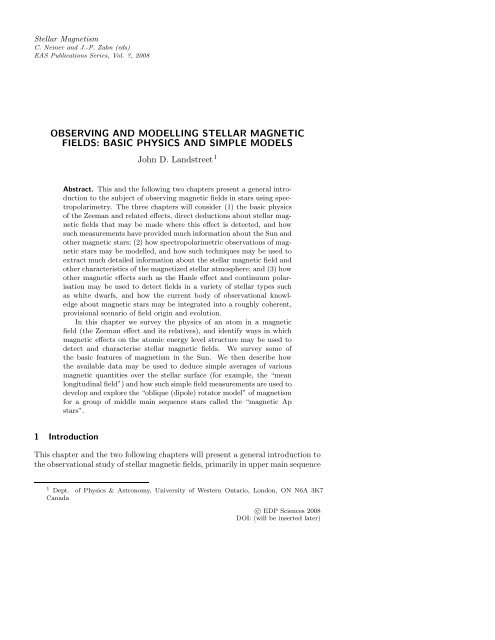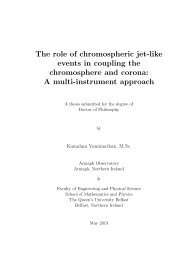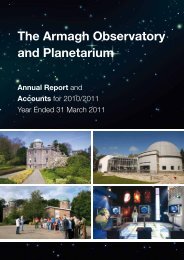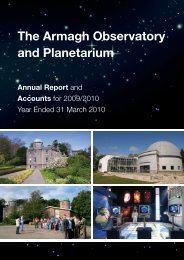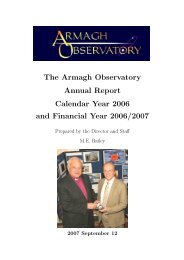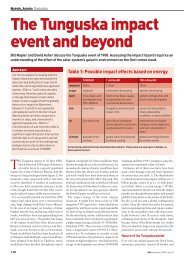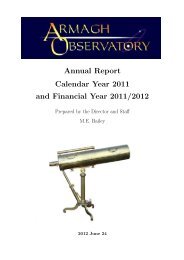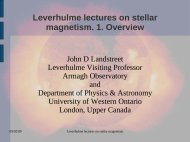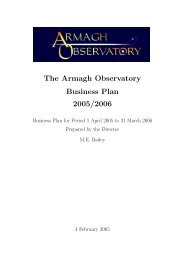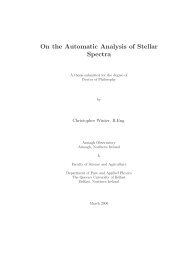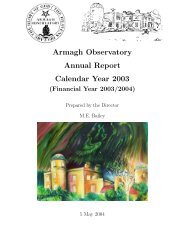OBSERVING AND MODELLING STELLAR MAGNETIC FIELDS ...
OBSERVING AND MODELLING STELLAR MAGNETIC FIELDS ...
OBSERVING AND MODELLING STELLAR MAGNETIC FIELDS ...
Create successful ePaper yourself
Turn your PDF publications into a flip-book with our unique Google optimized e-Paper software.
Stellar MagnetismC. Neiner and J.-P. Zahn (eds)EAS Publications Series, Vol. ?, 2008<strong>OBSERVING</strong> <strong>AND</strong> <strong>MODELLING</strong> <strong>STELLAR</strong> <strong>MAGNETIC</strong><strong>FIELDS</strong>: BASIC PHYSICS <strong>AND</strong> SIMPLE MODELSJohn D. Landstreet 1Abstract. This and the following two chapters present a general introductionto the subject of observing magnetic fields in stars using spectropolarimetry.The three chapters will consider (1) the basic physicsof the Zeeman and related effects, direct deductions about stellar magneticfields that may be made where this effect is detected, and howsuch measurements have provided much information about the Sun andother magnetic stars; (2) how spectropolarimetric observations of magneticstars may be modelled, and how such techniques may be used toextract much detailed information about the stellar magnetic field andother characteristics of the magnetized stellar atmosphere; and (3) howother magnetic effects such as the Hanle effect and continuum polarisationmay be used to detect fields in a variety of stellar types suchas white dwarfs, and how the current body of observational knowledgeabout magnetic stars may be integrated into a roughly coherent,provisional scenario of field origin and evolution.In this chapter we survey the physics of an atom in a magneticfield (the Zeeman effect and its relatives), and identify ways in whichmagnetic effects on the atomic energy level structure may be used todetect and characterise stellar magnetic fields. We survey some ofthe basic features of magnetism in the Sun. We then describe howthe available data may be used to deduce simple averages of variousmagnetic quantities over the stellar surface (for example, the “meanlongitudinal field”) and how such simple field measurements are used todevelop and explore the “oblique (dipole) rotator model” of magnetismfor a group of middle main sequence stars called the “magnetic Apstars”.1 IntroductionThis chapter and the two following chapters will present a general introduction tothe observational study of stellar magnetic fields, primarily in upper main sequence1 Dept. of Physics & Astronomy, University of Western Ontario, London, ON N6A 3K7Canadac○ EDP Sciences 2008DOI: (will be inserted later)
2 Stellar Magnetismand white dwarf stars. The basic questions that will be explored are the following.(1) Under what circumstances can we detect magnetic fields at the surface ofstars? What observational methods are useful for this? (2) What information canwe obtain about the field strength, the field structure, and related phenomena atthe surfaces of stars where fields are detected or inferred? (3) Are the observationsof fields in various classes of stars consistent with any overall scenario of field originand evolution?The plan of these chapters is to begin with a review of various aspects of thephysics of an atom in a magnetic field, particularly the Zeeman effect, and toexplore how such physics enables us to observe and study magnetic fields in stars.Then observations of stellar magnetism in the Sun and in upper main sequencestars (mostly in the “magnetic Ap stars”, about which the most is known) willbe discussed, with emphasis on how observations can be used to obtain “direct”measurements of various kinds of average fields, and how such measurements leadto definite conceptual models of the stellar fields observed.In the next chapter, the study of stellar fields by modelling of spectra andspectropolarimetric data is discussed. This method requires much more elaboratecomputational tools, but is capable of providing much more detailed informationabout the magnetic fields and related phenomena in stars.Finally, in the third of these chapters, we survey some recent advances in thestudy of magnetic Ap stars, and then return to physics to review the Hanle effect.We next turn to the continuum polarisation produced by megaGauss fields in whitedwarfs, and survey the fields found in (single) white dwarfs. The totality of datanow available about fields in pre-main sequence stars, main sequence stars, andwhite dwarfs suggests a dichotomy between fields in low-mass main sequence stars,which seem to be produced by contemporary dynamos, and those of upper mainsequence stars and their successors the magnetic white dwarfs, which appear tobe consistent with retention of a global field produced rather early in the star’shistory (the fossil field theory).The subjects of these chapters have been reviewed in several recent publications.A number of useful reviews on magnetism in many classes of stars are foundin Mathys et al. (2001). The connections between magnetism and stellar activity,particularly in the Sun and in low-mass stars, are discussed in Arnaud & Meunier(2003). Magnetic fields and related phenomena in upper main sequence stars aresurveyed in Balona et al. (2003). The many phenomena associated with magnetismin magnetic Ap stars are reviewed in Zverko et al. (2005). The chapterby Mestel & Landstreet in Wielebinski & Beck (2005) gives a general overviewof magnetism in stars, from both a theoretical and an observational perspective.Finally, Mestel (1999) provides a comprehensive view of the consequences of magneticfields for many aspects of stellar structure and evolution. (Mestel is currentlypreparing a second edition of this magisterial volume.)
Give a shorter title using \runningtitle 32 The atom in a magnetic field2.1 General ideasDirect detection and measurement of a stellar magnetic field is generally madepossible by the effect of the magnetic field on atoms in the stellar atmosphere,which results in changes in the structure and energies of atomic energy levels, andin turn leads to observable changes in the profiles and polarisation properties ofstellar spectral lines. The Zeeman effect is one example of these effects, but theinfluence of a magnetic field on atoms has several names in different regimes offield strength.We start by recalling the Hamiltonian of an isolated atom in a magnetic field,here written for the case of a central potential and L-S coupling, in the Gaussiancgs units that I will use throughout:H = − ¯h[2m ∇2 +V (r)+ξ(r)L · S+ −e]B · (L + 2S) +e22mc 8mc 2B2 r2sin 2 θ . (2.1)In this equation, of course, m and e are the electron mass and charge and c is thespeed of light; B is the vector magnetic field strength (magnetic induction); L andS are the orbital and spin angular momentum operators, and in the central fieldand L-S coupling approximation, the spin-orbit interaction isξ(r) = (m 2 c 2 /2)(1/r)(dV dr). (2.2)The first three terms of the Hamiltonian are respectively the kinetic energy, potentialenergy, and spin-orbit coupling energy. The last two terms are the magneticenergy, derived from describing the magnetic field using a vector potential (cf.Schiff 1955, Secs 38 and 39).For fields up to about 10 MG (megaGauss) = 1kT (kiloTesla), the magneticterms in Eq. 2.1 are small compared to the Coulomb potential V (r). In thissituation one may normally treat both the fine structure produced by the spinorbitcoupling, and the magnetic splitting, using perturbation theory on states ofthe Hamiltonian of the central field.For various field strengths B, the relative sizes of the spin-orbit energy and thetwo magnetic terms changes, leading to different perturbation treatments:• If the (quadratic field term) ≪ (linear field term) ≪ (spin-orbit term), theregime is known as the (linear) Zeeman effect.• If both (quadratic field term ≪ (linear field term) and the(spin-orbit term) ≪ (linear field term), the regime is known as the Paschen-Back effect.• If the (quadratic magnetic term) ≫ (linear magnetic term) and the(quadratic magnetic term) ≫ (spin-orbit term), the effect is called the quadraticZeeman effect.
4 Stellar MagnetismIt is interesting to get an idea right away of what actual magnetic field strengthslead to various regimes. To do this we need to estimate the size of the variousterms in Eq. 2.1, which we do by making the substitutions L ∼ ¯h, r ∼ a 0 (theBohr radius of the atom), and V ∼ Ze/a 0 . We find:• Normal atoms in fields of B < 50 kG (5T) are mostly described by theZeeman effect.• Fine structure splitting varies greatly from one atomic configuration to another,so a few spectral lines may be in the Paschen-Back limit at muchsmaller fields than normal. This occurs when two fine structure levels of thesame term are quite close together, so that two lines of a single multiplet arevery close in wavelength (say within 1 or 2 Å of each other in the visible). Anexample is the pair 6147.74 – 6149.24 Å of multiplet 74 of Fe ii. Similarly,line splitting in H and Li i is in the Paschen-Back regime for fields below30 kG.• Above about 100 kG, the quadratic term becomes important. The quadraticZeeman effect is observed in lines of H.• In a field of more than some tens of MG the magnetic terms become comparableto the Coulomb term, and a perturbation treatment is no longerpossible. In this situation one must solve for the structure of the atom inboth fields together. Since the electrostatic field of an atom has sphericalsymmetry while a magnetic Field has cylindrical symmetry, there is no naturalcoordinate system for this problem, and solution is really rather difficult.2.2 The Zeeman EffectIn the Zeeman (weak-field) regime, fine structure energy levels are only slightlyperturbed by the term (e/2mc)B · (L + 2S). If the atom is described by L-S coupling(a pretty good approximation for light atoms), J and m J are good quantumnumbers. The magnetic moment of the atom is aligned with J. Since the energyof a magnetic moment in a magnetic field (think of a small bar magnet) is proportionalto B · J, there are 2J + 1 different magnetic sublevels of each energy leveli whose energy in zero magnetic field is E i0 . These sublevels are found to haveenergies( e)E i = E i0 + g i Bm J¯h, (2.3)2mcwhere g i is a dimensionless factor usually lying between 0 and 3 that varies fromone energy level to another, and is given in L-S coupling by( )J(J + 1) + S(S + 1) − L(L + 1)g i = 1 +. (2.4)2J(J + 1)Spectral lines arise from allowed transitions between the energy levels given byEq. 2.3, with hν ij = E i − E j . This gives rise to a set of closely spaced frequencies
Give a shorter title using \runningtitle 5Zeeman components for sodium D linesgreen: pi components, red & blue: sigma componentsm J3/22P3/21/2-1/2-3/22P1/21/2-1/22S1/21/2JDL-2006-1/2Fig. 1. Zeeman splitting of the Na D doublet in a magnetic field.given byν ij = E i − E jh( ) e¯hB= ν 0 + (g i m i − g j m j ) , (2.5)2mchwhere the selection rule is that m j = m i ± 0, 1. The corresponding componentwavelengths areλ ij = c( ) eλ2= λ 0 + ∆λ Z = λ 0 + 0 Bν ij 4πmc 2 (g j m j − g i m i ), (2.6)where numerically, with λ in Å and B in G,∆λ Z (Å) = 4.67 10 −13 λ 2 0 B(g jm j − g i m i ). (2.7)Notice that the line splitting is proportional to B and to λ 2 .An important constraint on the components into which a single line splitsin the presence of a magnetic field is furnished by the selection rules, requiringm j = m i (called pi components) or m j = m i ±1 (called sigma components). Onlysome combinations of the sublevels into which each energy level splits produceactual lines. As an example, the Zeeman components of the sodium D lines at5889, 5895 Å are illustrated in Fig. 2.2. Notice that no allowed transition occursbetween the m J = +3/2 sublevel of the 2 P 3/2 level to the m J = −1/2 sublevel ofthe 2 S 1/2 level.The actual size of the line splitting is about ±0.012 Å (pi-sigma separation)for a transition at 5000 Å in a field of 1 kG.
6 Stellar MagnetismA special case occurs if the spacing of the upper energy sublevels is the sameas the spacing of the lower energy sublevels. In this case, all the line componentsproduced by the same value of ∆m J = m j −m i have the same wavelength (i.e. theyoverlap), and only three line components are observed. For historical reasons, thiscase is called the “normal Zeeman effect”. Usually, however the spacing of upperand lower levels is different (as in Fig. 2.2), and a larger number of line componentsappear. (This case is sometimes called the “anomalous Zeeman effect”.)A few specific lines have no splitting (some combinations of J, L and S, forexample 4 D 1 /2, can lead to a value of g i = 0 in Eq. 2.4, or one of the levels canhave J = 0, which means that m J in Eq. 2.3 is identically zero). Such lines arecalled “null lines” and are valuable aids to assessing line width due to factors otherthan magnetic splitting or broadening.Splitting of each energy level is determined by the Landé factor g i . The bestexperimental values have mostly been assembled by Charlotte Moore in three volumesas National Bureau of Standards Circular 467 (1949; 1952; 1958). A largenumber of Landé factors have been computed by R. L. Kurucz. Both these resources,and many others, are incorporated into the on-line Vienna Atomic LineDatabase (VALD: http://ams.astro.univie.ac.at/ vald/). In the absence of betterdata, however, calculated g i values using L-S coupling (Eq. 2.4), or equivalentexpressions for other coupling schemes as appropriate, usually provide useful estimates.2.3 The Paschen-Back EffectThe Paschen-Back effect has few astronomical applications in non-degenerate stars,although it is relevant for analysis of some of the weakest fields found in magneticwhite dwarfs. The fields found in main sequence stars (generally of the order of1 kG, very rarely as large as 30 kG) are not large enough to push most lines outof the Zeeman regime into the Paschen-Back regime.However, a few levels have abnormally small fine-structure separation, and linesproduced by transitions which involve such levels have splitting which is neitherpure Zeeman splitting nor pure Paschen-Back splitting, but are an intermediatecase known as “partial Paschen-Back splitting”. An example is furnished by theb 4 D 1/2 and the b 4 D 3/2 energy levels of Fe ii at 3.87 eV above ground; transitionsbetween these levels and the z 4 P ◦ 1/2level lead to the two lines 6147.74 and 6149.24of multiplet 74 which easily move into the transition regime for field strengthsfound in some main sequence stars.In the Paschen-Back regime, L and S decouple, so J is no longer a goodquantum number. Instead, the good quantum numbers are m L and m S , and theenergy perturbation due to the magnetic moment associated with the orbital andspin angular momenta separately is given byE i = E i0 +e2mc B(m L + 2m S )¯h. (2.8)With this perturbation, the separation between adjacent levels (eB/2mc) is the
Give a shorter title using \runningtitle 7same for all levels, and with the selection rule of ∆m L = m Lj − m Li = 0, ±1, alllines are split by the same amount, and we observe the “normal Zeeman triplet”.2.4 Polarisation properties of Zeeman line componentsAnother interesting property of the Zeeman components into which a spectral linesplits when the atom is immersed in a magnetic field is that the various componentshave distinctive polarisation properties. These turn out to be very important inpractice.“Natural” light may be thought of classically as being made up of short wavetrains that have no particular phase or plane of polarisation. However, by theuse of suitable “polarising” devices (such as sheet Polaroid, or reflection from adielectric surface at a suitable angle), it is possible to force electric vectors of thewave trains to vibrate in a single plane. Such light is called “linearly polarised”,and the plane of the electric vector is the “plane of polarisation”.If such linearly polarised light is forced to travel through an anisotropic buttransparent medium (such as a sheet of mica or a suitably orientated crystal quartzplate) which has the property that waves linearly polarised in one plane (the “fastaxis”) travel a little faster than waves polarised in a plane at 90 ◦ to the first plane(the “slow axis”), a wave with a plane of polarisation at 45 ◦ to both fast and slowaxis will effectively be resolved into the sum of two linearly polarised waves, onetravelling with its electric vector parallel to each of the crystal axes. If the speedof travel of these components were the same along both axes, when the wave trainemerged from the crystal the two component waves would have the same phaserelation as when they entered, so the linearly polarised wave we are consideringwould remain linearly polarised in the original plane.However, if the difference in wave velocity and the thickness of the plate areadjusted so that one of the two components is retarded by one-quarter cycle withrespect to the other component, the emerging wave has a new kind of polarisation:“circular polarisation”. In this state, if we look at the direction of the electricvector at an instant all along the wave train, it follows a spiral form in space.Alternatively, if we look at the wave at one point in space as it varies in time (forexample at the point where it emerges from our anisotropic crystal, or “quarterwave plate”), the fact that the two orthogonal components into which we haveresolved the wave are now 90 ◦ out of phase means that the wave vector rotatesonce per wave period (hence the term “circular polarisation”).The various Zeeman components into which a spectral line splits when the atomis in a magnetic field are polarised. This polarisation depends on the orientationof the field with respect to the direction of the emitted light. Two simple casesoccur.If the field is perpendicular to the line of sight, then transitions with ∆m = 0(pi components) are linearly polarised with their electric field vectors parallel to thefield lines. Transitions with ∆m = ±1 (sigma components) are linearly polarisedperpendicular to the field.If the field is aligned parallel to the line of sight, the line components produced
8 Stellar Magnetismby ∆m = 0 transitions vanish (they have zero intensity), while the transitions forwhich ∆m = 1 and −1 have opposite senses of circular polarisation.Intermediate field orientations lead to elliptical polarisation of the light fromthe various Zeeman components.The quantum mechanics of multi-electron atoms, including the Zeeman effect,is described with the aid of simple classical models in Eisberg & Resnick (1985).A more advanced discussion, again with a reasonable emphasis on the physics ofmulti-electron atoms, is found in Bransden & Joachain (1983).3 Detecting and measuring stellar magnetic fields3.1 The magnetic field(s) of the SunThe physics discussed so far is enough to allow us to detect a magnetic field in astar and to estimate its strength.As we will discuss in more detail below, the fact that individual Zeeman componentsof a magnetically split spectral line emit polarised light also means thatthese same components absorb only light of specific polarisation. For example,with a longitudinal field, the sigma component of a spectral line that emits rightcircularly polarised light also absorbs right circularly polarised light while havingno effect on left circularly polarised light. This means that at the wavelength of thissigma component, more radiation exits the star as left circularly polarised light:there is a net left circular polarisation at that wavelength, and correspondingly,net right circular polarisation at the wavelength of the other sigma component.The first magnetic field discovered in any star occurred with the detection ofthe magnetic field of a sunspot by Hale (1908). Small regions on the solar surfacewere already being observed with high spectral resolution, and it had been noticedthat spectral lines in sunspots are noticeably broadened, and at sufficiently highresolution actually split into multiple components. Hale hypothesized that thesplitting is magnetic, and confirmed his idea with the aid of a circular polarisationanalyser by showing that the line components in the red and blue components ofthe spectral line are circularly polarised in opposite senses, exactly as expectedfrom the Zeeman effect. From the separation of the outer line components, Halewas able to estimate that the sunspot field producing the splitting was about3000 G (about 0.3 T). Notice that even in this first detection of a stellar magneticfield the polarisation properties of the Zeeman effect played a critical role.Hale’s discovery initiated the study of sunspot magnetic fields, which blossomedduring the next 50 years (see for example Bray & Loughhead 1964). A number ofgeneral characteristics of sunspots and of their occurrence on the Sun have beenidentified from these studies.• Sunspot fields are typically between 1 and 3 kG. The field strength dropsoff to a much smaller value (at least as averaged over many thousand km onthe solar surface) outside the sunspot.
Give a shorter title using \runningtitle 9• Sunspots tend to come in pairs of opposite magnetic polarity, which areusually aligned in a roughly east-west direction on the solar surface. Atany one time, in one hemisphere of the Sun the leading sunspot of a pairtends to have one specific polarity (say, north polarity), while in the oppositehemisphere, the leading sunspots have the opposite polarity (say, south).• During a roughly 11-year period, sunspots (which individually usually lastfor some months) are formed at first about 30 ◦ − 40 ◦ from the equator.As time goes on they appear closer and closer to the solar equator. As thesunspot production regions approach the equator, the production of sunspotsdies out.• When the next 11-year cycle stars, the sign of the magnetic field of the leadingsunspots in each hemisphere has changed. Thus if the leading sunspotsin the northern hemisphere had north polarity during one cycle, during thenext cycle they usually have south polarity. The real period of the solarcycle is thus approximately 22 years rather than 11.• The Sun displays numerous other variable localized features (flares, filaments,coronal loops, plages, etc) which collectively are referred to as “solaractivity”. The amount of this activity is roughly proportional to the numberof sunspots visible at one time.In the 1950’s magnetic fields began to be detected over the full solar disk.This general solar magnetic field has been found to be highly intermittent, bothspatially and temporally. It seems to be concentrated in small magnetic flux ropes(of which the sunspots can be regarded as the largest examples), which emergefrom below the surface, move about with large-scale convective flows of variousscales, and vanish again. The global magnetic field of the Sun has a loose dipolarorganisation, with much emerging flux in one hemisphere and returning flux in theother. This overall pattern, like the sign of leading sunspots in one hemisphere,reverses every 11 years, again confirming that the fundamental period of solarvariation is 22 years.The magnetic fields of the solar surface are responsible for all forms of solaractivity. The solar photosphere looks fairly bland and unstructured in white light,apart from the sunspots, but as one looks higher, up into the chromosphere andcorona, the outer solar atmosphere becomes very highly structured and complex.This complexity is very clear in an image of the solar corona at X-ray wavelengthsobtained by the Yokoh satellite (Fig. 3.1). All this complexity is controlled by thesolar magnetic field.3.2 Detection of fields in other starsFor nearly 40 years after the first detection of the solar magnetic field, no furtherfields were found in any other stars. Why not? Basically because the sunspotfields satisfied some very special conditions.
10 Stellar MagnetismFig. 2. Solar corona as seen in Xrays. The complex structure of dense and rare gas andof temperature variations (which determine the brightness at various points above thedark solar surface) is completely controlled by the magnetic field of the Sun.• The Sun is very bright, so high dispersion spectroscopy was possible on thesolar spectrum long before photographic emulsions were sensitive enough tomake this possible on other stars.• The Sun rotates very slowly, and sunspots are quite localised on the solardisk. Spectral lines from sunspots are not broadened at all by rotationalDoppler broadening.• The fields of sunspots are relatively strong, strong enough to produce visiblesplitting of the very narrow spectral lines.Zeeman splitting in stars is quite small (of the order of 0.01 Å per kG); evenvery small rotation velocities can mask this completely. (For line splitting to bedetectable in a typical stellar spectral line, very roughly the field in kG mustbe larger than the projected rotation velocity in kms −1 .) Such splitting wasnot observed in any of the relatively bright stars that could be studied at highdispersion in the 1930’s and 1940’s.Stellar fields were finally discovered by Horace Babcock, who had the cleveridea of exploiting the polarisation properties of the Zeeman effect to improve thesensitivity to weak magnetic fields. He equipped the coudé spectrograph of theMount Wilson 100-inch telescope with polarising optics. Let’s see why this wassuch an interesting new tool.
Give a shorter title using \runningtitle 11Fig. 3. Effects of Zeeman splitting and polarisation on stellar spectral lines. The rightcolumn shows the situation for a magnetic field normal to the line of sight; the left columnis for a magnetic field parallel to the line of sight. The top row shows the apparentlaboratory splitting. The second row compares the non-magnetic line (dotted) to theline profile with the applied magnetic field (solid). In the third row are shown profiles asviewed through right and left circular analysers (left) or linear polarisers aligned paralleland perpendicular to the field. The bottom row shows fractional polarisation signalsderived from the row above.3.3 Observing polarisation in stellar spectral linesThe effects of a magnetic field on a stellar spectral line are sketched in Fig. 3.3. Inthe top row, the laboratory splitting of a spectral line is shown (in the usual notationwith pi components above the line, sigma components below, and componentline lengths showing relative intensity). The second row shows how a stellar lineprofile in a non-magnetised atmosphere (dotted) would change when a magneticfield is introduced: the Zeeman splitting basically broadens the line, somewhatmore if the field is along the line of sight (so that all the visible components are
12 Stellar Magnetismoffset from the line position in zero field) than if the field is normal to the line ofsight. The line broadening is significant, of course, only if the Zeeman splitting iscomparable to the width of the line produced by other broadening agents such asthermal and rotational broadening. Often the dominant broadening is by rotation.Notice that the broadened line is not very different from a line broadened a littlemore by rotation; to securely detect a field using line broadening, one must seeactual line splitting or detect a correlation between line width and the pi-sigmacomponent separation of the atomic Zeeman pattern, which varies by a factor oforder two or three among common spectral lines.The third row shows the spectral line as observed through a polarising filterpassing only one of left or right circularly polarised light (left column) orlight linearly polarised parallel or perpendicular to the field direction on the sky(right column). If instead of a single spectrum, two spectra are obtained, observedthrough the two polarising filters of either the left or right panel, the differencesin line profiles as seen in the two spectra provide information about the field. Theleft column is especially interesting: the spectral line as seen in left circularly polarisedlight is not at the same wavelength as the right circularly polarised light.This means that field detection may be achieved by measuring the radial velocitydifference between the positions of the line profile in left and right circularlypolarised light, something which can be done with a precision much better thanthe line width. Thus fields small enough not to change the intensity profile of theline very much can nevertheless produce easily detectable signals. This result hasbeen the key to most of the magnetic field detections in stars.3.4 Discovery of fields in main sequence starsBabcock (1947, 1958a, 1958b) searched for magnetic fields by obtaining circularlyanalysed spectra of various types of stars. He did this essentially by placing aquarter-wave plate in the light beam of the telescope, followed by a linear polarisationbeam-splitting analyser. The effect of the quarter-wave plate is to convertcircularly polarised light into linearly polarised light. Right circularly polarisedlight becomes linearly polarised light of one orientation, while left circularly polarisedlight is converted into light linearly polarised at right angles to the lightthat was formerly right circularly polarised. Thus light initially entering the telescopeas right or left circularly polarised light remains in a distinctive (but nowlinear) polarisation state.The light beam is then passed through a calcite plate (or a Wollaston prism).These devices have the effect that they make the light of two orthogonal linearpolarisations follow different paths, so the two linear polarisation states emergefrom the analyser moving along slightly different axes (or in slightly different directions).The two separated beams are then focussed on the slit of a spectrograph.Effectively there are now two star images on the slit, one of which carries the lightthat was left circularly polarised as it left the star, and the other of which was rightcircularly polarised. These two star images then pass through the spectrographand form two parallel spectra on the detector. The simplest method of detecting
Give a shorter title using \runningtitle 13the field is then to measure the radial velocity difference between lines as seen inthese two spectra, as illustrated in the third row, left column of Fig. 3.3. If thesignal in a single line is weak (the radial velocity difference is very small) a moreprecise measurement may be obtained by averaging over many spectral lines.Babcock restricted his search to stars having sharp spectral lines (projectedrotational velocities v e sini of less than 20 or 30 kms −1 ). This is because the smallradial velocity differences between the lines as seen in spectra of the right and leftcircularly polarised light is much easier to measure if the spectral lines are narrowthan if they are broad. Starting in 1947, he discovered the Zeeman polarisationsignature of a magnetic field in a number of middle main sequence stars belongingto a type of unusual objects classified from their spectra as “peculiar A stars”.These are stars which appear similar to normal A and late B main sequence stars,but (a) show spectral lines of abnormal strength or weakness of various elementscompared to the lines of typical A and late B stars (Si, Cr, Ti or rare earth linesmight be unusually strong, He lines might be very weak), and (b) have v e sin ivalues that are usually less than about 60 or 80 kms −1 , compared to values of 200or 300 kms −1 which are usually found in A and B stars.Clear illustration of how the measurements were done is found in Babcock(1958a, Figs. 1 & 2; but be sure to consult a printed edition of this article ifpossible, as the ADS on-line copy of Fig. 2 is nearly black).Note that Babcock (1958a thought that he had detected weak fields (of order1 − 2 10 2 G) in several other categories of stars, but that most of these measurementsturn out to have larger uncertainties than originally estimated, and thedetections have not been confirmed.4 Measuring and modelling Ap star magnetic fieldsOnce Zeeman splitting is detected in the spectra of an Ap star, the next problemis to turn measurements of spectral line shifts between the spectra of rightand left circularly polarised light into useful information about the strength anddistribution of the magnetic field over the stellar surface, and potentially evenas a function of depth in the atmosphere. The basic idea of how to do this wasintroduced by Babcock, who showed that the separation between the average positionof a spectral line as seen in the spectra of right and left circularly polarisedstarlight is approximately proportional to the line-of-sight component of the stellarfield, (suitably) averaged over the hemisphere of the star that is visible at thetime of observation. Thus one can go from a measurement of wavelength shiftbetween the positions of a spectral line in the spectra of right and left polarisedlight to the deduction of an important characteristic of the field present on thevisible stellar hemisphere, namely the average of the line-of-sight field componentover that hemisphere. This does not describe the magnetic field fully, but at leastit provides one very useful kind of information about the field.Several such relations have been found that are useful for going directly fromsome measurement on spectra to some average (or moment) of the field over thevisible hemisphere of the star. These relationships have made it possible to develop
14 Stellar Magnetismsimple models of the magnetic field geometry of Ap stars. As we shall see, thesemodels are not exact but do contain much useful information about the globalnature of the fields observed.Two particular relationships between measurements and average field strength,the weak-field approximation and the weak-line approximation, have both beenfound to be very useful in estimating the mean line-of-sight (or mean longitudinal)magnetic field component, often called 〈B z 〉. Both of these relationshipsrequire measurements of spectra of right and left circularly polarised starlight.Measurement of actual line splitting, in those few stars that have large enoughfields combined with small enough rotational line broadening, provide a differenttype of field average. In this case, one can estimate the mean value of the absolutevalue of the field strength 〈|B|〉, often called the mean field modulus or meansurface field, B s . Measurement of B s requires only a single (intensity) spectrumthat is not analysed for polarisation.4.1 The weak-line approximationIn an optically thin gas producing emission or absorption lines in a magnetic fieldB, the separation between the sigma and pi components of a triplet line is givenby Eq. 2.7,∆λ σ−π = z λ2 eB4πmc 2 = 4.67 10−13 zλ 2 0B, (4.1)where z is the effective Landé factor of the line. Looking at Fig. 4.1, it is plausiblethat when we observe a split spectral line through (say) a right circular polariser,as the inclination of the field varies from transverse to longitudinal (the angleθ between the field and the line of sight varies from π/2 to 0), the shift of thecentroid of the line is given by ∆λ σ−π cosθ. If we observe the same line through aleft circular polariser, the centroid of the transmitted line is −∆λ σ−π cosθ. If weobserve the spectral line simultaneously in both right and left circularly polarisedlight, the separation of the line centroids as seen through the two polarisers willbe ∆λ = 2∆λ σ−π cosθ.Therefore, if we observe the spectrum of a magnetic star in both senses ofcircularly polarised light, and measure the wavelength shift ∆λ between the centroidsof a line as seen in left and in right circularly polarised light, we can solvethe equation above to derive a value for B cosθ. Clearly, if the spectral line usedis formed over the whole visible hemisphere of the star, the field strength derivedis a hemispheric average of the line-of-sight component of the field, precisely thequantity we have been calling 〈B z 〉. And of course using many lines and averagingthe result improves the precision of the measurement.The weak-line expression is accurate only for optically thin (or weak) lines,but it provides a reasonable first approximation for strong lines as well, and it iscommon to use it on all measured lines regardless of strength.Notice that unless we know exactly how the contribution to the spectral linevaries over the stellar surface, we do not know exactly how the value of 〈B z 〉 is
Give a shorter title using \runningtitle 1510.80.60.40.20-1.5 -1 -0.5 0 0.5 1 1.5wavelength in units of pi-sigma separationFig. 4. The two curves in the figure show a fully Zeeman split spectral line as viewedthrough a circular polarisation analyser that passes only one sense of circular polarisation.The upper curve shows the line formed in a magnetic field perpendicular to the line ofsight, so that all three (normal) Zeeman components are visible. The lower curve (whichis shifted downward by 0.3 for visibility) shows the same line as it appears with themagnetic field parallel to the line of sight, so that the central pi component vanishesand only one sigma component is visible. In the case of transverse field the centroid ofthe profile is at wavelength 0, while for the longitudinal field the centroid is at +1. Forintermediate field inclinations the centroid shifts as cos θ, where θ is the angle betweenthe field and the line of sight.weighted from centre to limb. This is a common problem with all field momentsderived from simple line measurements.4.2 The weak-field approximationIf, in addition to being weak, the spectral line as seen in right and left circularlypolarised light is shifted by much less than its (local) width, a further approximationis sometimes useful (for example in measurements with Balmer lines; seeLandstreet 1982 and Bagnulo et al. 2002). This approximation relates the circularpolarisation as measured directly in one wing of the spectral line to 〈B z 〉. ConsiderFig. 4.2. We have already seen that measurement of ∆λ, the separation betweenthe mean position of a spectral line as seen in right and left polarised light, maybe used to determine 〈B z 〉. This separation may be determined by observing thefull spectral line profile in each polarisation, but sometimes it is observationallymore convenient (for example when using a polarimeter equipped with a narrowband interference filter) to measure the circular polarisation at only one or twopoints on the line profile. Such a measurement, together with a scan of the lineprofile, can also provide a value for ∆λ.
16 Stellar Magnetism10.80.60.4∆ λ0.20-1.5 -1 -0.5 0 0.5 1 1.5wavelength from line centreFig. 5. A spectral line, slightly split by the Zeeman effect, as observed in right (solidline) and left (dotted line) polarisation. The circular polarisation is measured in the linewing at the position indicated by the vertical long-dashed line.If we know the slope dI/dλ of the line profile at the wavelength where thecircular polarisation is measured (the vertical dashed line in Fig. 4.2), clearlythe vertical separation between the two profiles there is given approximately byI L − I R = (dI/dλ)∆λ. Since the fractional circular polarisation measured at thatpoint with a polarimeter will be V = (I L − I R )/(I L + I R ) = (dI/dλ)∆λ/(I L + I R )from a measurement of V and the line profile I(λ) we can solve for ∆λ which inturn provides an estimate of 〈B z 〉 as in the previous section.4.3 Basic characteristics of magnetic Ap starsUsing one or another of the methods discussed above, measurements of 〈B z 〉 havebeen made for more than 100 Ap stars. In many cases several or even manymeasurements are available for a star. When these data are examined, we find thefollowing regularities.• The value of 〈B z 〉 is usually variable. The variations are always periodic, andare almost always sinusoidal. Usually 〈B z 〉 reverses sign during the variation.• Almost all the magnetic Ap stars also vary in brightness, by a few percent,with the same period as the magnetic variations.• Most magnetic Ap stars show variations in spectral line shape and strength.The lines of each element all show rather similar variations, but differentelements may show quite different variations (one element’s lines may bestrongest when the lines of another element are weakest, for example). Again,the period of variation is the same as that of field and light.
Give a shorter title using \runningtitle 17• The period of variation may have any value between about 0.5 d and manyyears. There is no obvious difference between variations with a short periodand those occurring with a long period. On the other hand, the period isclosely related to v e sin i: stars with long periods invariably have small v e sin ivalues, while stars with large v e sin i always have short periods.• These facts together clearly show that the period of variation is the rotationperiod of the star, and in fact it is found that the observed periods andv e sin i values are consistent with main sequence radii of the stars, usingthe elementary relationship v e sin i = 2πR sin i/P. This relationship may beused to derive sini if the radius R is accurately known (for example for starsfor which distance and effective temperature are precisely determined).• Apart from the periodic variations due to rotation of a non-axisymmetricfield and abundance structure, the fields seem to be quite stable, and thereare no hints yet of changes in the abundance distributions. The only irregularityseems to be that a very small number of magnetic Ap stars areapparently slowing down very gradually.Typical variations of a magnetic Ap star are illustrated in Fig. 4.3.The sinusoidal variations of 〈B z 〉, usually with a reversal of sign, suggeststhat we are seeing the rotation of a roughly dipolar field, which is inclined tothe rotation axis of the star. This means that as the star rotates, we (for moststars) see first one magnetic pole and then the other. The variations in spectralline profile and strength strongly suggest that the chemical composition variesover the surface of a magnetic Ap star: the star has “abundance patches”. Theseabundance patches are presumably the cause of light variations (for a very niceconfirmation of this, see Krtička et al. 2007). This model, of a star with a simplemagnetic field structure whose axis inclined (“oblique”) to the rotation axis, isknow as the oblique rotator model.The simplest oblique rotator is a magnetic dipole whose axis is inclined at someangle β to the rotation axis, which of course is also inclined by an angle i to theline of sight. For this simplest model, to fully specify everything, we must providea value for i, one for β, and the polar strength of the dipole B d . This makesthree parameters. But a simple sinusoidal variation of 〈B z 〉 only provides twoconstraints, for example the mean value of 〈B z 〉 and the amplitude of variation, orthe minimum and maximum values of 〈B z 〉. Other information such as the timeof maximum field provides nothing useful for the three parameters we need. Inorder to use the variation of 〈B z 〉(t) (known in the trade as a “magnetic curve”)to determine the parameters uniquely, it is necessary to determine i, usually fromv e sini and the stellar radius. To define this model better, or to use one with moreparameters, we need more information about the field.4.4 The mean field modulus and better Ap magnetic modelsAnother kind of information about the field that is sometimes available, and veryuseful if it is, is the mean value of the field strength 〈|B|〉, averaged over the
18 Stellar MagnetismFig. 6. Variations observed in the magnetic Ap star HD 119419 as a function of phasethrough the 2.60 d period. The curves show (from the top) the variations of equivalentwidth of Fe and Si lines, of brightness in the Johnson UBV bands, and of 〈B z〉.visible stellar hemisphere, and known as the mean field modulus or mean surfacefield B s . This number is accessible in stars in which the value of v e sin i is smallenough, and the field large enough, that actual line splitting into components (orat least broadening of the most Zeeman-sensitive lines) is observable. This usuallyrequires a v e sin i value of at most a few kms −1 , and a field strength of some kG.For stars for which such splitting (or excess broadening) is detectable, the basicmeasurement method is to measure the wavelength separation between the pi andsigma components (or between the two sigma components) and use Eq. 2.7 todetermine the mean field modulus. An example of the kind of splitting that couldbe measured is shown in Fig. 3 in the next chapter; the mean field modulus in thisstar is about 34 kG! The value of B s sometimes (but not always) varies roughlysinusoidally too.With two more constraints from measurements of B s (say maximum and minimumvalues during one rotation), we can not only constrain the three parameters
Give a shorter title using \runningtitle 19Fig. 7. Models of several field moments measured for HD 187474. The upper left panelshows 〈B z〉, and the lower right panel shows B s, with data superposed on a fit usingco-linear dipole, quadrupole, and octupole. (There is enough information in the data setto constrain one additional parameter.)of the dipole rotator, but add a second field component, which might for examplebe a linear quadrupole field aligned with the dipole, for which we need onlyspecify one more polar field strength. This additional field component would allowus to bunch the field lines together at one pole and spread them apart at theother, creating a strong pole and a weak pole, a situation frequently required bythe data. A particularly attractive aspect of this kind of approximate modellingis that it enables us to obtain a qualitative picture of the overall field structurewithout detailed computation of line profiles. An example of such modelling, fromLandstreet & Mathys 2000, is shown in Fig. 4.4.Such simple modelling nevertheless allows us to obtain some rather importantinsights into the nature of the magnetic fields of Ap stars.• The fact that Zeeman-split spectral lines mostly have well-defined sigma andpi components, and that in lines for which the splitting pattern happens tohave no component at zero displacement (i.e. the multiple pi components allseparate from the zero-field wavelength), indicate that the fields of the Apstars are fairly homogeneous. These stars do not seem to have the mixtureof regions of fairly strong field and other regions essentially free of field thatcharacterise the field structure of solar-type stars.
20 Stellar Magnetism• Typically, the largest values of 〈B z 〉 is of the order of 0.2 or 0.3 of the valueof B s . This is only possible if the field has a globally dipolar topology, withmost field lines entering the star on one hemisphere and exiting on the other.A more complex field structure would reduce 〈B z 〉 to a much smaller fractionof B s .• In general, in stars where it is possible to measure B s , the two magneticpoles do not have equal characteristic field strengths. One pole is usuallystronger than the other. This is probably connected with the fact (at firstrather surprising) that elements which have a patchy distribution may havea maximum abundance near one pole and a minimum near the other: if thepoles are “different”, the abundance patterns could be too.5 ConclusionsWe find that the physics of the Zeeman effect provides us with several robust toolswith which to detect and measure the magnetic fields of stars. Such fields havebeen known for many years on the Sun and on the Ap stars. The solar field isstrongly structured on a small length scale, and strongly variable on a short timescale. In contrast, the fields of Ap stars seem to be structured rather simply, andare constant in time in their intrinsic structure over the star; no real changes seemto occur, only the periodic changes due to stellar rotation. We suspect that thesetwo types of fields have rather different origins, which we will discuss in Chapter3.ReferencesArnaud, J. & Meunier, N. 2003, editors, “Magnetism and Activity of the Sun and Stars,EAS Pubs. Series No. 9 (Paris, EDP Sciences)Babcock, H. W. 1947, ApJ 105, 105Babcock, H. W. 1958a, ApJS 3, 141Babcock, H. W. 1958b, ApJ 128, 228Bagnulo, S., Szeifert, T., Wade, G. A., Landstreet, J. D. & Mathys, G. 2002, A&A 389,191Balona, L., Henrichs, H. F. & Medupe, R. 2003, editors, “Magnetic Fields in O, B andA Stars”, ASP Conf. Series No. 305 (San Francisco: Astronomical Society of thePacific)Bransden, B. H. & Joachain, C. J. 1983, “Physics of Atoms and Molecules”, (London:Longman) ch. 8Bray, R. J. & Loughhead, R. E. 1964, “Sunspots”, (New York: Wiley)Eisberg, R. & Resnick, R. 1985, “Quantum Mechanics of Atoms, Molecules, Solids, Nuclei,and Particles”, (New York: John Wiley & Sons), ch. 10Hale, G. E. 1908, ApJ 28, 315Krtička, J., Mikulášek, Z., Zverko, J. & Žižńovský, J. 2007, A&A 470, 1089Landstreet, J. D. 1982, ApJ 258, 639
Give a shorter title using \runningtitle 21Landstreet, J. D. & Mathys, G. 2000, A&A 359, 213Mathys, G., Solanki, S. K. & Wickramasinghe, D. T. 2001, editors, “Magnetic FeildsAcross the Hertzsprung-Russell Diagram”, ASP Conf. Series No. 248 (San Francisco:Astronomical Society of the Pacific)Mestel, L. 1999, “Stellar Magnetism”, (Oxford: Clarendon Press)Moore, C. “Atomic Energy Levels”, 3 vols., NBS Circular 467 (Washington: NBS)Schiff, L. I. 1955, “Quantum Mechanics”, (New York: McGraw-Hill)Wielebinski, R. & Beck, R. 2005, editors, “Cosmic Magnetic Fields” (Berlin: Springer-Verlag)Zverko, J., Žižňovský, J., Adelman, S. J. & Weiss, W. W. 2005, editors, “The A-StarPuzzle”, IAU Symposium No. 224 (Cambridge: Cambridge University Press)


